When it comes to single-action revolvers, commonly referred to as cowboy guns, America’s appetite seems alive and healthy. Nostalgia plays a part in this interest, and so does Cowboy Action Shooting. We tested three revolvers whose forebears may have vied for sales in the Old West beginning in 1873. The Taylor’s & Company Devil Anse is named after a famous American gunner and is a Colt Single Action Army clone. The Taylor’s & Company Remington 1858 conversion is a reproduction of the typical conversions performed on original cap-and-ball revolvers. This revolver retains the ability to fire black powder in the cap-and-ball fashion if the shooter purchases a black-powder cylinder. We also tested a reproduction of the Smith & Wesson Schofield revolver. This is a clone of Smith & Wesson’s break-top revolver that was intended to compete with Colt’s original SAA revolver. The Smith & Wesson was successful in overseas sales and had some success in the states as well. It should be stressed that there is no clear purpose for these handguns, other than pride of ownership and recreational shooting. Our research indicates the SAA type is preferred above all others in Cowboy Action Shooting, although a few use competing types.
How We Tested
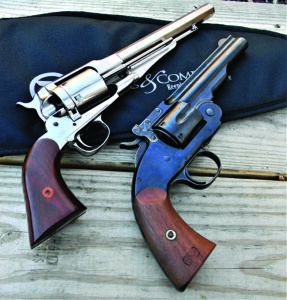
We were able to get together six types of ammunition for the test. We used the Winchester 255-grain round-nose load, Black Hills Ammunition’s 250-grain cowboy load, Remington’s 230-grain jacketed hollow points, a few Blazer 200-grain jacketed hollow-point loads, and a handload using the MattsBullets.com 255-grain bullet and Titegroup powder for 783 fps. Interestingly, the Remington, with its 8-inch barrel, developed the lowest velocity of the three revolvers. Also, we attempted to use 45 Colt Aguila loads, but we found the ammo’s low report and light recoil concerning. When we clocked three rounds of this on the chronograph, we found velocities of 415 fps, 360 fps, and 390 fps. Cowboy loads usually clock about 650 fps, so we felt there was some danger of a bullet sticking in the barrel. The Aguila loads were much too light. We used the handloads primarily during offhand firing, setting off 36 rounds in each revolver. We fired quickly, firing with one hand at 5 and 7 yards and two handed at 15 yards.
Read on to discover which revolver you may enjoy the most and to see which one fits your style.
Gun Tests Grade: B
$1290
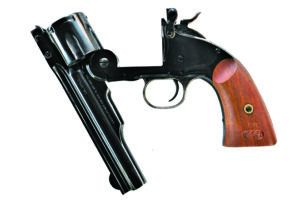
This is a storied revolver. The Smith & Wesson top-break revolvers were an alternative to the Colt Single Action Army. They offered a top-break system that ejected all spent cases automatically and was much easier to load quickly. The early Smith & Wesson 44 American and 44 Russian revolvers were less robust than the later No. 3 Schofield. Designed by a high-ranking Army officer named Col. George Schofield (pronounced Sko-field), the redesigned top-break latch was not only stronger, it would be operated with one hand. (Top-break revolvers are also properly referred to as hinged-frame revolvers.) Schofield’s improved barrel latch on the frame was added to a single-tooth spring-and-cam design that snapped the extractor into place when this tooth contacted the revolver’s strop. These improvements and a change to the rear sight resulted in the No 3. revolver. The No 3. Schofield was the fastest-loading American revolver, at least equal to the British Webley. The Model 3 also featured a redesigned grip that some felt fit their hand well. The original Army issue was a 7-inch-barrel revolver.
| Action Type | Single-action revolver |
| Overall Length | 11.0 in. |
| Overall Height | 5.2 in. |
| Minimum Width | 1.6 in. |
| Weight Unloaded | 45.0 oz. |
| Weight Loaded | 47.5 oz. |
| Barrel | 5.0 in. |
| Capacity | 6 |
| Frame | Steel |
| Front Strap Height | 2.6 in. |
| Rear Strap Height | 3.5 in. |
| Grips | Walnut |
| Grip Thickness | 1.5 in. |
| Grip Circumference Max | 5.4 in. |
| Front Sight | Fixed Post |
| Rear Sight | Inverted V in barrel latch |
| Sight Radius | 6.5 in. |
| Trigger Pull Weight Single Action | 6.0 lbs. |
| Trigger Span SA | 2.6 in. |
| Warranty | 5 years |
| Telephone | (877) SIXGUN1 [749-4861] |
| Website | Cimarron-Firearms.com |
| Made In | Italy |
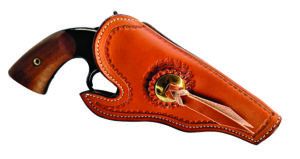
The version tested is a type known as the Wells Fargo revolver. Many Schofield revolvers were sold as surplus from the original 8000- to 9000-unit Army order with their barrels shortened to 5 inches. Many were purchased by Wells Fargo, hence the nickname. The originals were chambered for a short cartridge called the 45 Schofield. It was felt that the ejection system would not reliably eject the longer 45 Colt cartridge. Eventually, the Army adopted the shorter cartridge over the 45 Colt, earning the 45 Colt’s “Long Colt” nomination that lasts to this day. The shorter cartridge’s specifications were a 230-grain bullet at 830 fps in most loadings.
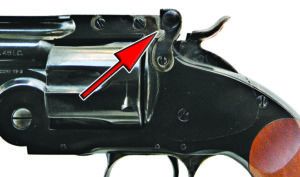
This new Cimarron No. 3 revolver, made by Uberti, is chambered for the 45 Colt and seems to work well with the 45 Colt cartridge. Modern designers solved whatever problem there was, while the original worked around the short 44 Russian cylinder. However, our Cowboy Action Shooter noted that the longer cylinder and redesigned gas ring isn’t perfect for long-term shooting. Some have experienced binding in the cylinder when firing a good quantity of 45 Colt loads. We did not experience this problem, although it seems to be documented.
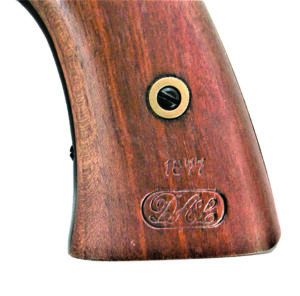
This is a large revolver. At 43 ounces, it is well balanced but feels quite different from the other two revolvers. The trigger action takes some getting used to. At 6.5 pounds, trigger compression is heaviest of the test. The revolver’s manual of arms is unique. Pull the barrel latch to the rear — it may be done with one hand — and open the hinged frame. The chambers are exposed for loading. If the barrel is tilted enough, the spring-loaded ejector rod is activated. When spent cases are in the chambers, they are ejected simultaneously. While this is a fast system, it has some quirks. As an example, if you have not fired all of the cartridges and attempt to eject the gun, the loaded cartridges are seldom fully ejected. They will escape the ejector because the 45 Colt cartridge does have a rather narrow cartridge case rim and fall back under the ejector star, causing a tie up. Just the same, this is by far the fastest and easiest system to use of the three revolvers. We don’t recommend energetically activating the system with a flick of the wrist because parts wear would probably occur, but the revolvers seem robust and reliable.
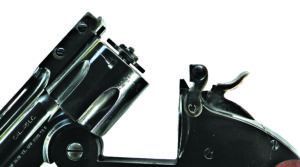
The sight is a half-moon type front post and a simple but effective fixed rear sight. Sight regulation was good with this revolver, with 250-grain loads striking to the point of aim at 25 yards. As for safety, this is the only revolver tested safe to fully load with six cartridges. Load all six chambers and then move the hammer to half cock. The cylinder will free wheel until the hammer is cocked. Or, use the preferred sequence in all cowboy guns, load five cartridges and lower the hammer on an empty cylinder.
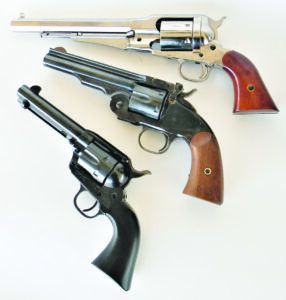
The fit and feel of the Schofield revolver are so different from the SAA types we have often tested that the combat firing stage went slower than the other revolvers. We were not familiar with the Remington, either, but it is closer to familiarity than the Schofield. During the combat firing stage, we found that the Schofield is fairly accurate in deliberate shooting but wins no prizes for speed. Cock the hammer and aim and press the trigger and you get a hit. Other than occasionally binding a loaded cartridge during the ejection process, there were no problems during the combat course, and the Schofield isn’t meant to eject loaded cartridges. We rated the Schofield down on close-range combat accuracy compared to the other revolvers. For a recreational shooter, this doesn’t matter but it is interesting. We drew the revolver during the test from a beautiful and period-authentic Rocking K Saddlery holster.
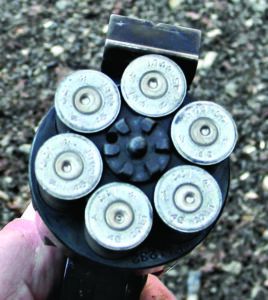
In accuracy, we were prepared to find the Schofield the most accurate of the three revolvers due to reputation. We were careful with our bracing, aim, and trigger press, but it wasn’t to happen. The Schofield was the least accurate of the three revolvers tested. Some of the groups, at 4 inches at 25 yards, were twice the size of the Remington replicas efforts. While still useful for recreational shooting, these results were disappointing. We noted slight tears in the paper, oblong to the bullet hole, the other revolvers did not demonstrate. The revolver may have suffered a nicked barrel crown at some point during manufacture or handling.
Our Team Said: In the end, we like the Schofield. It is just the ticket for a jaded shooter looking for something different. It is fast enough and accurate enough, if not as fast and accurate as the others. The substantial effort to reload the Remington might become tiring. Loading the Schofield was effortless. We rated the revolver down a full grade on accuracy.
45 Colt Range Data
All groups were fired at 25 yards from a benchrest position using an MTM Universal Shooting rest. We used a Competition Electronics Pro Chrony to measure velocities. The first screen of the chronograph was 10 feet from the muzzle of the firearm.| Black Hills 250-grain Cowboy | Taylor’s Devil Anse | Taylor’s Remington 1858 | Cimarron Schofield |
| Average Velocity | 699 fps | 675 fps | 714 fps |
| Muzzle Energy | 271 ft.-lbs. | 253 ft.-lbs. | 283 ft.-lbs. |
| Smallest group | 1.8 in. | 1.6 in. | 2.9 in. |
| Average Group | 2.4 in | 2.1 in. | 4.0 in. |
| Winchester 255-grain RNL | Taylor’s Devil Anse | Taylor’s Remington 1858 | Cimarron Schofield |
| Average Velocity | 694 fps | 671 fps | 688 fps |
| Muzzle Energy | 273 ft.-lbs. | 255 ft.-lbs. | 268 ft.-lbs. |
| Smallest Group | 2.5 in. | 2.0 in. | 3.8 in. |
| Average Group | 2.9 in. | 3.3 in. | 4.4 in. |
| Remington 230-grain JHP | Taylor’s Devil Anse | Taylor’s Remington 1858 | Cimarron Schofield |
| Average Velocity | 865 fps | 857 fps | 880 fps |
| Muzzle Energy | 382 ft.-lbs. | 375 ft.-lbs. | 395 ft.-lbs. |
| Smallest Group | 2.7 in. | 2.5 in. | 3.6 in. |
| Average Group | 2.9 in. | 2.9 in. | 4.2 in. |



























